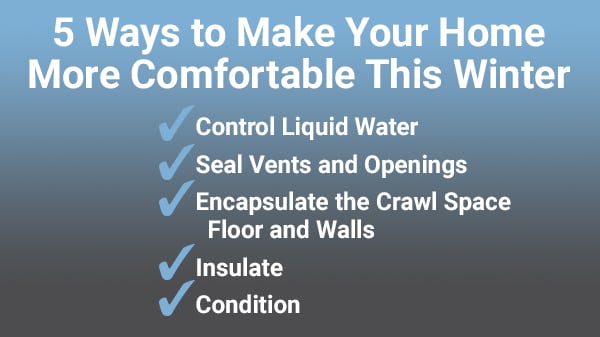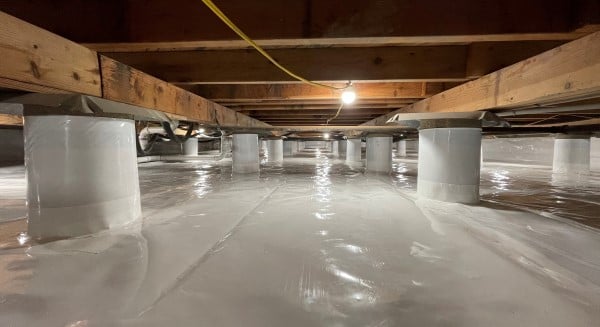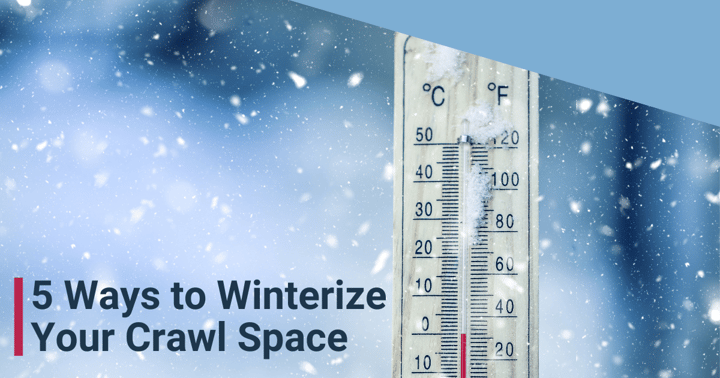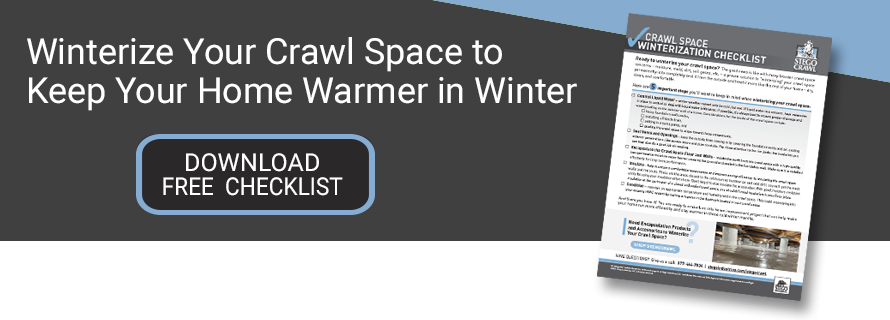Cold Feet? How to Prepare Your Crawl Space for Winter Temperatures
Make Your Home More Comfortable in the Colder Months with Our Free Crawl Space Winterization Checklist
Recently, I was talking to a homeowner who said one of the main reasons they made the decision to work on their crawl space was because their feet get cold walking around their house, especially in the winter months. It was a physical clue to them that something was going on in that forgotten space beneath their floor which needed to be addressed. I like my feet warm too, so while it’s a good enough reason to make improvements, there are other impacts that cold temperatures in your crawl space can have on the overall performance of your home.
Let me share with you what you can do to keep your home warmer in those cold winter months.
🏡 Reasons for Cold Feet (Literally)... In Your Home
For this homeowner, it didn’t take long for them to understand the reasons why their feet were getting cold during the winter. First of all, crawl spaces tend to be cooler by nature. They are generally below-grade, which will be a lower temperature than the inside of the home, especially when the home is heated during the winter. The earth outside the crawl space, particularly toward the surface, will certainly be even colder during times of the year with cold ambient temperatures, snow, etc.
Like many homes built on crawl spaces, this one also had open foundation vents. There are a number of reasons why building science has shown open foundation vents in crawl space tend to cause more harm than good. Some of these considerations tend to focus on parts of the country where warm, humid air movement can infiltrate vented crawl spaces and create moisture-related problems. But there are also potential concerns in other geographic areas where cold outside air is more likely to migrate into the home’s crawl space during parts of the year.
To make matters worse for these homeowners, there was no insulation in their crawl space. Imagine walking outside on a cold day bundled up in snow gear but wearing only sandals on your feet; that’s how their house was essentially built. This is common in older homes where the crawl space was generally considered more on the outside of the home than part of its interior.
⇧ Increased Stack Effect in the Winter Months
Cold temperatures in the crawl space are part of the problem, but they become more pronounced due to the natural movement of air in and out of homes, known as the stack effect.
Like a chimney, this building science phenomenon causes air entering the home from lower floors – like the crawl space – to flow up and out the top of the house through attic vents or other openings in the envelope. We all remember “warm air rises,” but as it rises and escapes, it is replaced by air from below to maintain an equilibrium. The stack effect is strongest in winter months where the house is being heated, increasing the degree of airflow the colder it is outside.
Stack effect is a big reason why we often say this: what is in your crawl space can affect your entire home. If the crawl space air is cold, stack effect will move that cold air through the home.
❄️Winter Temperatures in Crawl Space Homes
Here is a closer look at some of the potential impacts cold temperatures can have in homes with crawl spaces:
- Cold Floors Above the Crawl Space - the floor above your crawl space is the first part of the home the cold air hits and cools down. Insulation in the floor joists can help, but traditional fiberglass batt insulation can still allow air movement through and is prone to absorb moisture in vented, unsealed crawl spaces, often making it ineffective.
- Drafts - a similar issue as above, but particularly with gaps in the floor, the cold air movement can be felt as uncomfortable drafts into your living space.
- Inefficient HVAC Systems - the movement of cold air through the home can impact how hard your HVAC system must work, affecting the costs of keeping your home comfortable. You are essentially paying extra for that cold air from the crawl space to be heated to the temperature you’ve set your HVAC system to. Frustratingly, the heated air rises and escapes, only to be replaced by more cold air from below. It’s a tremendously inefficient cycle.
- Moisture Problems - despite some traditional thinking, cold air is not necessarily without moisture. Ambient Relative Humidity (RH)—the ratio of how much moisture is in the air to how much it can hold at a given temperature— can often be higher in the winter. This is because while absolute humidity may decrease (the numerator in the RH ratio) in cold air, its capacity to hold moisture also decreases (meaning the denominator also decreases). Any moisture in the crawl space (from the ground, melting snow, or moving through vents or foundation cracks) can create a higher absolute and relative humidity environment. Higher RH can lead to condensation as that air finds surfaces at dewpoint temperature, and that water can absorb into the wood or insulation in your crawl space.
- Cold or Freezing Ducts and Pipes - for crawl spaces that contain HVAC equipment (one of the benefits of crawl spaces), lower temperatures make your ductwork cold, forcing the system to work harder to deliver air at proper temperatures throughout the home, costing more money. At freezing temperatures, plumbing pipes in the crawl space could potentially burst -- causing costly water damage and headaches.
- Pests and Rodents - in cold climates, bugs and critters may seek the relative safety and comfort of a crawl space. These pests can cause further damage to crawl space components, contribute to poor Indoor Air Quality, and emit odors.
🌡️ A Warm Solution: 5 Ways to Make Your Home More Comfortable This Winter
The good news is like with many broader crawl space concerns – moisture, mold, dirt, soil gases, etc. – a proven solution to “winterizing” your crawl space permanently is to completely seal it from the outside and treat it more like the rest of their home – dry, clean, and comfortable.
Always check your local building codes, but here are the important steps you’ll want to keep in mind:
- Control Liquid Water - winter weather cannot only be cold, but wet. If liquid water is a concern, have measures in place to control or deal with liquid water infiltration. If possible, it’s always best to ensure proper drainage and waterproofing on the exterior wall of a home. Considerations for the inside of the crawl space include:
- fixing foundation wall cracks
- installing a French drain,
- putting in a sump pump, and
- grading the crawl space to slope toward the drain components.
- Seal Vents and Openings - keep the outside from coming in by covering the foundation vents and air-sealing penetrations to the exterior, like access doors and pipe conduits. Pay close attention to the rim joists: the insulation you use may also do a good job air-sealing (see #4).
- Encapsulate the Crawl Space Floor and Walls - isolate the earth from the crawl space with a high-quality, low-permeance moisture vapor barrier covering the ground and sealed to the foundation wall. Make sure it is installed effectively for long-term performance.
- Insulate - help maintain a comfortable temperature and improve energy efficiency by insulating the crawl space walls and rim joists. These are the areas closest to the cold sources (outdoor air and cold dirt), so you’ll get the most utility focusing your insulation efforts here. Don’t forget to also insulate the access door if it opens to the outside. With effective insulation at the perimeter of a closed and sealed crawl space, you shouldn’t need insulation in your floor joists.
- Condition - maintain an appropriate temperature and humidity within the crawl space. This could mean tying into your existing HVAC system by cutting a register in the ductwork located in your crawl space.
Your crawl space and the rest of your home are now more alike and working together.
 To boil this down, we’ve also created a checklist for you to keep handy when you embark on this home improvement project – because unlike the 20th Century thinking of crawl space construction, this area is most certainly part of your home.
To boil this down, we’ve also created a checklist for you to keep handy when you embark on this home improvement project – because unlike the 20th Century thinking of crawl space construction, this area is most certainly part of your home.
You’ll see a lot of benefits to a clean, dry, and comfortable crawl space… including happy feet.
Editor's note: This blog post was initially published in December 2021 and has been revised to stay up-to-date.

Written by Tom Marks
Tom Marks is the Business Development Project Manager with Stego Industries, LLC. He has been with Stego since 2007, serving many years as the Rocky Mountains Regional Manager. Now, his focus is geared toward vapor barrier solutions for new and existing homes as the Product Manager of the StegoHome and StegoCrawl brands. In addition, Tom serves as Sustainability Manager, overseeing Stego’s leadership in holistic product and corporate sustainability. Tom enjoys working with a wide range of project team members and customers to incorporate effective sub-slab vapor protection and create healthy, sustainable homes and buildings.
- Stego (26)
- StegoCrawl (24)
- Stego-Awareness (17)
- StegoHome (15)
- Case Studies (14)
- StegoCrawl-Consideration (12)
- StegoCrawl-Awareness (11)
- Customer Stories (9)
- Stego-Consideration (9)
- Pango (8)
- StegoHome-Consideration (8)
- Beast (7)
- How to Install (7)
- StegoHome-Awareness (7)
- Drago (5)
- Pango-Awareness (5)
- Beast-Awareness (4)
- Beast-Consideration (3)
- Drago-Awareness (3)
- Pango-Consideration (3)
- Stego IQ (3)
- Drago-Consideration (2)
- StegoCrawl-Decision (2)
Popular Posts
Stay Connected.
Enter your email below.










Post Comments